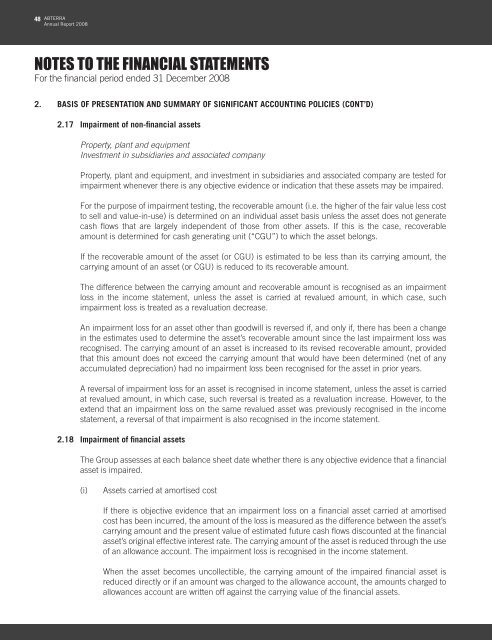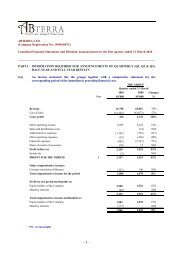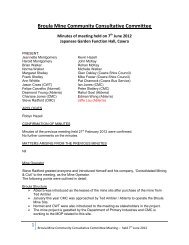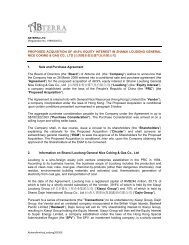AR for 2008 - Abterra
AR for 2008 - Abterra
AR for 2008 - Abterra
Create successful ePaper yourself
Turn your PDF publications into a flip-book with our unique Google optimized e-Paper software.
48 ABTERRA<br />
Annual Report <strong>2008</strong><br />
NOTES TO THE FINANCIAL STATEMENTS<br />
For the financial period ended 31 December <strong>2008</strong><br />
2. BASIS OF PRESENTATION AND SUMM<strong>AR</strong>Y OF SIGNIFICANT ACCOUNTING POLICIES (CONT’D)<br />
2.17 Impairment of non-financial assets<br />
Property, plant and equipment<br />
Investment in subsidiaries and associated company<br />
Property, plant and equipment, and investment in subsidiaries and associated company are tested <strong>for</strong><br />
impairment whenever there is any objective evidence or indication that these assets may be impaired.<br />
For the purpose of impairment testing, the recoverable amount (i.e. the higher of the fair value less cost<br />
to sell and value-in-use) is determined on an individual asset basis unless the asset does not generate<br />
cash flows that are largely independent of those from other assets. If this is the case, recoverable<br />
amount is determined <strong>for</strong> cash generating unit (“CGU”) to which the asset belongs.<br />
If the recoverable amount of the asset (or CGU) is estimated to be less than its carrying amount, the<br />
carrying amount of an asset (or CGU) is reduced to its recoverable amount.<br />
The difference between the carrying amount and recoverable amount is recognised as an impairment<br />
loss in the income statement, unless the asset is carried at revalued amount, in which case, such<br />
impairment loss is treated as a revaluation decrease.<br />
An impairment loss <strong>for</strong> an asset other than goodwill is reversed if, and only if, there has been a change<br />
in the estimates used to determine the asset’s recoverable amount since the last impairment loss was<br />
recognised. The carrying amount of an asset is increased to its revised recoverable amount, provided<br />
that this amount does not exceed the carrying amount that would have been determined (net of any<br />
accumulated depreciation) had no impairment loss been recognised <strong>for</strong> the asset in prior years.<br />
A reversal of impairment loss <strong>for</strong> an asset is recognised in income statement, unless the asset is carried<br />
at revalued amount, in which case, such reversal is treated as a revaluation increase. However, to the<br />
extend that an impairment loss on the same revalued asset was previously recognised in the income<br />
statement, a reversal of that impairment is also recognised in the income statement.<br />
2.18 Impairment of financial assets<br />
The Group assesses at each balance sheet date whether there is any objective evidence that a financial<br />
asset is impaired.<br />
(i)<br />
Assets carried at amortised cost<br />
If there is objective evidence that an impairment loss on a financial asset carried at amortised<br />
cost has been incurred, the amount of the loss is measured as the difference between the asset’s<br />
carrying amount and the present value of estimated future cash flows discounted at the financial<br />
asset’s original effective interest rate. The carrying amount of the asset is reduced through the use<br />
of an allowance account. The impairment loss is recognised in the income statement.<br />
When the asset becomes uncollectible, the carrying amount of the impaired financial asset is<br />
reduced directly or if an amount was charged to the allowance account, the amounts charged to<br />
allowances account are written off against the carrying value of the financial assets.








